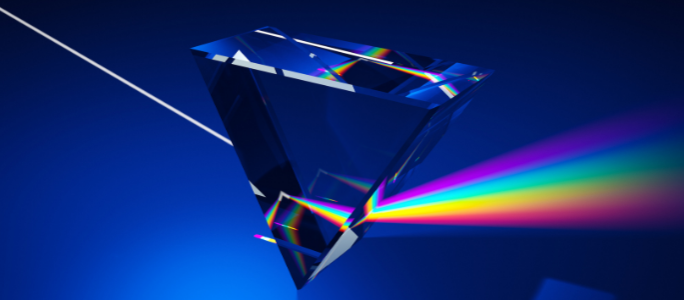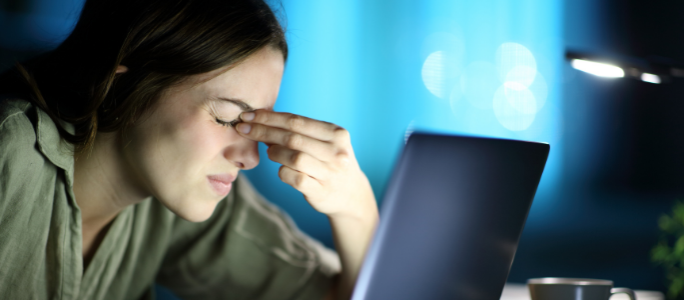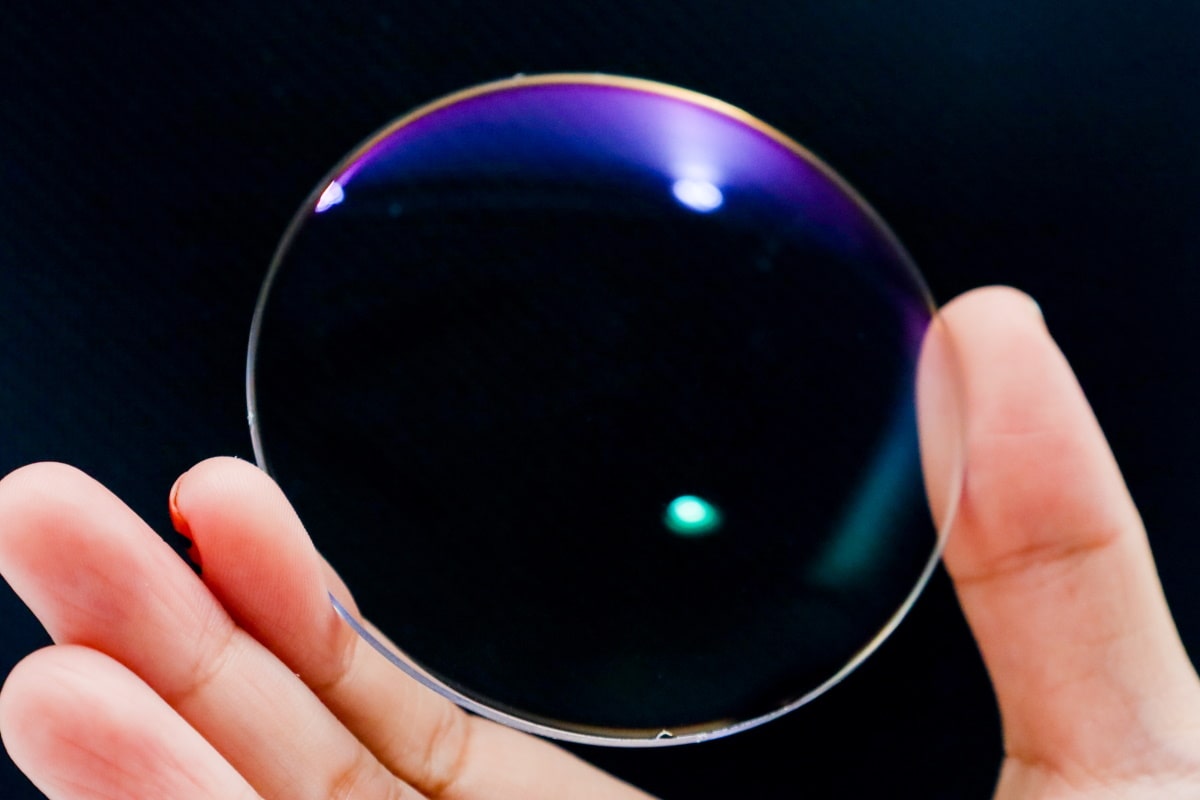What Is Blue Light? (& Is It Really That Bad for You?)
If you’re reading this on an electronic device, you’re being exposed to blue light at this very moment!
In fact, it’s impossible to escape sources of blue light, whether it’s from gadgets like our phones or laptops, or the fluorescent lightbulbs overhead.
Which leads us to the million-dollar question: What exactly is blue light and is it bad for you?
In this article, we’ll shed light (pun intended) on everything you need to know about blue light and how you can protect yourself from overexposure.
What is blue light anyway?
Blue light falls on the visible light spectrum. It’s one of the seven different colored lights that come together to make up white light – that is, the kind of light that is emitted from sources like the sun and electronics.
Even though it’s impossible to discern blue light from white light through the naked eye, shining a torch through a prism will visibly refract white light into all seven colors of the rainbow.
Among these colors, blue light is known for having the shortest wavelength and highest energy – which coincidentally, is perfect for deflection in the earth’s atmosphere. It’s what gives the sky the baby blue hue that we all know and love!
White light – and by extension, blue light – is everywhere around us at all times. The biggest natural source of white light is the sun. Other artificial sources of white light include light-emitting diodes (LED lights), fluorescent lights and electronic devices.
This means that, from the moment we’re born, we’re constantly surrounded by different forms of blue light. Even when we switch off our devices!
While this might sound alarming, it’s nothing to worry about. The world is constantly surging with all kinds of invisible electromagnetic energy, of which blue light is just another wave.
In comparison to Ultraviolet (UV) rays, which can severely damage your skin and eyes through prolonged exposure, the effects of blue light from digital devices can be considered relatively mild.
Is blue light bad for my health?
While the effects of overexposure to blue light may not be extremely damaging, it’s still a part of our lives that we should be vigilant about, especially in a world that’s becoming increasingly digital.
Here are some of the negative effects that blue light has on us:
1. It’s a major culprit behind digital eyestrain
The number one cause for concern when dealing with blue light is that it’s linked to eyestrain and computer vision syndrome.
Research has proven that when we use blue-light-emitting devices such as our phones or computers, we tend to blink less, providing our eyes with less moisture than they would otherwise have.
Due to this, you might notice discomfort when looking at a screen, such as dry or tired eyes, and even headaches or migraines.
While these problems may not seem like much cause for concern, it should be noted that over a long period of time, the effects may compound and amplify, leading to other, bigger problems, such as age-related macular degeneration (AMD) and an increased likelihood of contracting eye diseases.
2. It may be why you toss & turn on sleepless nights
Overexposure to blue light, especially during evenings or at night, can also cause a disruption to our sleep cycle and patterns.
Blue light is known to help regulate the body’s circadian rhythm, or also known as your sleep-wake cycle. Before the invention of artificial blue light sources, the presence of blue light from the sun meant that it was still daytime, and as such, our bodies would be stimulated to stay awake longer.
However, the presence of phones and laptops late at night can fool a body’s light sensors into thinking it is still daytime, which leads to problems such as a reduction in the production of melatonin (a hormone inducing sleepiness), insomnia or restless sleep.
3. It’s been linked to obesity, heart disease and diabetes
A study by Harvard suggests that the consumption of blue light at night may be indirectly linked to deadly diseases such as diabetes, heart disease and obesity.
While further studies are required to definitively confirm the connection between blue light and these diseases, findings from existing research so far seem to support this link.
The study showed that when a group of participants’ circadian cycles were slowly shifted, their blood sugar levels rose to a dangerous pre-diabetic state. Additionally, their levels of leptin, a hormone that provides the feeling of being full after meals, were decreased. While both of these changes in hormone levels may not be the outright cause of diabetes and obesity, they seem to at least be a part of the problem.
Furthermore, the disruption of one’s circadian cycles may also lead to shorter sleep times or restless sleep, which in turn has been linked to higher chances of depression, diabetes and heart disease.
Wait… Are there any health benefits of blue light?
Despite all of the negative effects that late night or overconsumption of blue light may cause, it’s important to remember that blue light itself is not necessarily bad for your health. In fact, a healthy dose of blue light during the daytime may even be to your benefit.
As we’ve mentioned, the presence of blue light triggers sensors in our bodies to keep us awake, so it should come as no surprise that it helps to boost alertness and improve your reaction times.
Additionally, there’s evidence of blue light being able to help improve one’s memory and cognitive functions, as well as uplift moods.
While these benefits may not make up for the potential risks and adverse side effects of blue light, it’s best to remember that blue light may do more harm at night. During the daytime, the presence of blue light is inevitable and even beneficial.
3 ways to protect yourself from too much blue light
Even though blue light is everywhere around us, there are still steps you can take to limit your exposure to it.
1. Turn off your devices at night
The easiest way to limit your exposure to blue light is to go completely cold turkey and turn off all your devices once the clock strikes a certain hour.
This way, the only blue light that you may come into contact with would come from your overhead lights, and even so, it won’t be long before they’re turned off for a good night’s rest.
If that’s too difficult, there are other ways of limiting your blue light intake. For instance, you could set daily reminders of your blue light consumption on your phone to ensure that you remember to disconnect.
Besides that, you could also pick up evening hobbies that don’t involve electronic devices, such as reading or knitting, or even playing board games with any people you live with.
2. Grab a pair of blue light blocking glasses
Another way to protect yourself from blue light is to purchase a pair of blue light blocking glasses.
This tip is especially useful for those who need to spend a lot of time in front of screens, such as office workers or students. These glasses can filter out blue light and reduce the amount reaching your retinas.
These glasses may also reduce some of the adverse effects listed above, such as eyestrain, giving you the opportunity to focus for longer hours without any of the negative consequences.
These days, it’s possible to get blue light glasses in both prescription and non-prescription forms – which means you can reap their benefits whether you need glasses or not.
At Mouqy, most of our frame designs come with the option of blue light blocking lenses. Go ahead and check out our collection!
3. P/S: Remember to take breaks!
Another way to reduce blue light intake is to take breaks more frequently.
Instead of staring at your devices for hours on end, it would be better for your eye health if you took some time to stare at a faraway (preferably non-blue light-emitting) object.
If you’re ever in doubt, just remember the 20/20/20 strategy, where you should ideally stop work every 20 minutes to focus on an object 20 feet away, for 20 seconds. In addition to reducing your blue light consumption, this strategy can also help to decrease eye strain and potentially even increase your productivity.
So yes, blue light protection matters!
All in all, even though blue light may be beneficial during some times of the day, it’s important to remember that it can still adversely affect our eye health and overall wellbeing, especially if consumed during hours when we should be resting instead.
Now that you know everything there is to know about blue light, don’t forget to spread the word to your friends and family members so they too can protect themselves!

Written by:
Pixie Tan

Reviewed by:
Dr. Melody Huang















